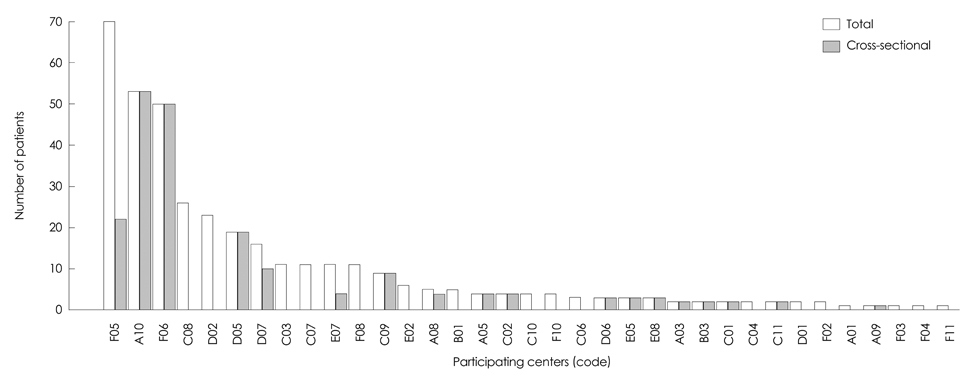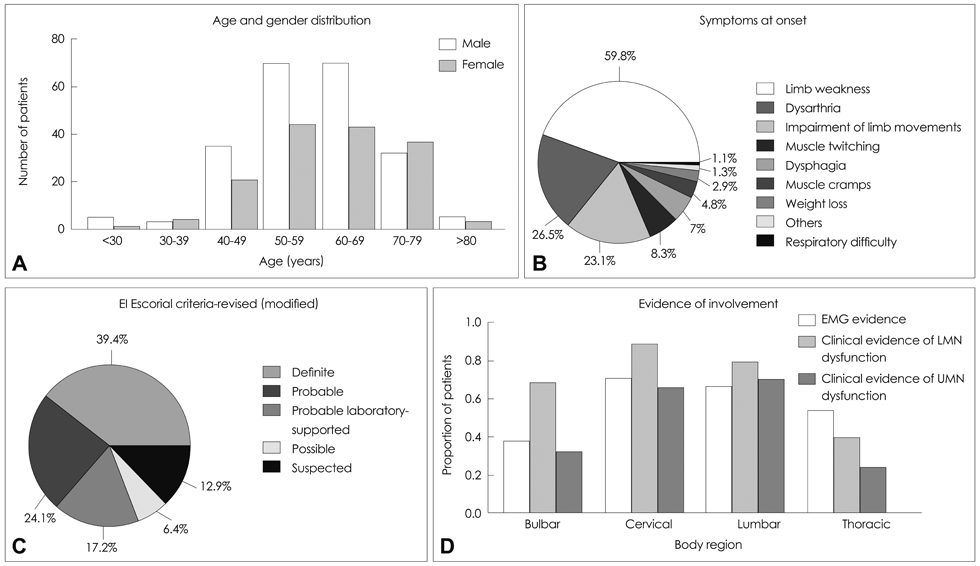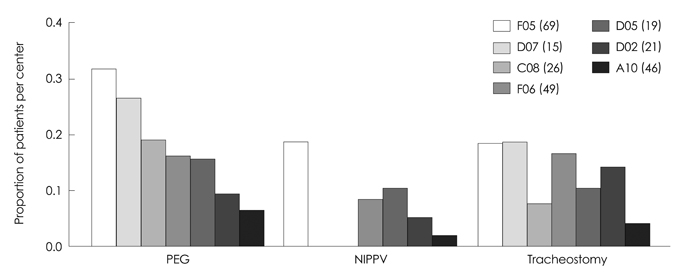J Clin Neurol.
2012 Dec;8(4):293-300. 10.3988/jcn.2012.8.4.293.
Current Status of the Diagnosis and Management of Amyotrophic Lateral Sclerosis in Korea: A Multi-Center Cross-Sectional Study
- Affiliations
-
- 1Department of Neurology, Inje University College of Medicine, Busan, Korea.
- 2Department of Neurology, Seoul National University College of Medicine, Seoul, Korea.
- 3Department of Neurology, Hanyang University College of Medicine, Seoul, Korea. kimsh1@hanyang.ac.kr
- 4Department of Neurology, Chungnam National University College of Medicine, Daejeon, Korea.
- 5Department of Neurology, Korea University College of Medicine, Seoul, Korea.
- KMID: 2287581
- DOI: http://doi.org/10.3988/jcn.2012.8.4.293
Abstract
- BACKGROUND AND PURPOSE
Recently published, evidence-based guidelines should alter the management of amyotrophic lateral sclerosis (ALS)/motor neuron disease (MND). However, the newest recommendations for ALS/MND therapy are not reflected in actual clinical practice. We sought to evaluate the current status of the diagnosis and management of ALS in Korea.
METHODS
The Korean ALS/MND research group was organized in 2010, involving more than 50 neurologists from neuromuscular centers in Korea. Participating centers collected data from April to September 2010 on the diagnosis and management of patients with ALS. Data forms from the ALS patient care database, which is a component of the ALS clinical assessment, research, and education program (http://www.outcomes-umassmed.org/ALS/), were modified and used for data collection.
RESULTS
In total, 373 sporadic ALS cases from 35 centers were enrolled. The demographic features and clinical findings were similar to those in previous reports from other countries. The mean age at onset was 50-60 years, and a slight male predominance was observed. The enrolled patients predominantly showed focal onset of cervical or lumbosacral symptoms. Only about one-half of the indicated patients (31.4%) received a physician's recommendation for a parenteral gastrostomy, and 18.1% underwent the procedure. Noninvasive ventilation was recommended in 23% of patients, but applied in only 9.5% of them. Tracheostomy was performed in 12.7% of patients.
CONCLUSIONS
The demographic and clinical features of the diagnosis and management of ALS in Korea are similar to those reported in other countries; however, supportive management, as recommended in evidence-based guidelines, are not yet widely recommended or performed for patients with ALS in Korea.
MeSH Terms
Figure
Cited by 1 articles
-
Prognostic Role of Serum Levels of Uric Acid in Amyotrophic Lateral Sclerosis
Seong-il Oh, Soojeong Baek, Jin-Seok Park, Liying Piao, Ki-Wook Oh, Seung Hyun Kim
J Clin Neurol. 2015;11(4):376-382. doi: 10.3988/jcn.2015.11.4.376.
Reference
-
1. Kiernan MC, Vucic S, Cheah BC, Turner MR, Eisen A, Hardiman O, et al. Amyotrophic lateral sclerosis. Lancet. 2011. 377:942–955.
Article2. Miller RG, Jackson CE, Kasarskis EJ, England JD, Forshew D, Johnston W, et al. Practice parameter update: the care of the patient with amyotrophic lateral sclerosis: multidisciplinary care, symptom management, and cognitive/behavioral impairment (an evidence-based review): report of the Quality Standards Subcommittee of the American Academy of Neurology. Neurology. 2009. 73:1227–1233.
Article3. Miller RG, Jackson CE, Kasarskis EJ, England JD, Forshew D, Johnston W, et al. Practice parameter update: the care of the patient with amyotrophic lateral sclerosis: drug, nutritional, and respiratory therapies (an evidence-based review): report of the Quality Standards Subcommittee of the American Academy of Neurology. Neurology. 2009. 73:1218–1226.
Article4. Miller RG, Rosenberg JA, Gelinas DF, Mitsumoto H, Newman D, Sufit R, et al. Practice parameter: the care of the patient with amyotrophic lateral sclerosis (an evidence-based review): report of the Quality Standards Subcommittee of the American Academy of Neurology: ALS Practice Parameters Task Force. Neurology. 1999. 52:1311–1323.
Article5. Lechtzin N, Wiener CM, Clawson L, Davidson MC, Anderson F, Gowda N, et al. Use of noninvasive ventilation in patients with amyotrophic lateral sclerosis. Amyotroph Lateral Scler Other Motor Neuron Disord. 2004. 5:9–15.
Article6. Mitsumoto H, Davidson M, Moore D, Gad N, Brandis M, Ringel S, et al. Percutaneous endoscopic gastrostomy (PEG) in patients with ALS and bulbar dysfunction. Amyotroph Lateral Scler Other Motor Neuron Disord. 2003. 4:177–185.
Article7. Miller RG, Anderson F, Brooks BR, Mitsumoto H, Bradley WG, Ringel SP, et al. Outcomes research in amyotrophic lateral sclerosis: lessons learned from the amyotrophic lateral sclerosis clinical assessment, research, and education database. Ann Neurol. 2009. 65:Suppl 1. S24–S28.
Article8. Logroscino G, Traynor BJ, Hardiman O, Chio A, Couratier P, Mitchell JD, et al. Descriptive epidemiology of amyotrophic lateral sclerosis: new evidence and unsolved issues. J Neurol Neurosurg Psychiatry. 2008. 79:6–11.
Article9. Bradley WG, Anderson F, Bromberg M, Gutmann L, Harati Y, Ross M, et al. The American Academy of Neurology. Current management of ALS: comparison of the ALS CARE Database and the AAN Practice Parameter. Neurology. 2001. 57:500–504.10. Miller RG, Anderson FA Jr, Bradley WG, Brooks BR, Mitsumoto H, Munsat TL, et al. ALS C.A.R.E. Study Group. The ALS patient care database: goals, design, and early results. Neurology. 2000. 54:53–57.
Article11. Baek W, Park A, Kim HY, Kim SH. Amyotrophic lateral sclerosis in Korea: clinical characteristics and prognostic factors. J Korean Neurol Assoc. 2011. 29:16–24.12. Bae JS. A proposal for the establishment of an Korean ALS database. J Korean Neurol Assoc. 2008. 26:Suppl 3. S106–S107.13. Brooks BR. El Escorial World Federation of Neurology criteria for the diagnosis of amyotrophic lateral sclerosis. Subcommittee on Motor Neuron Diseases/Amyotrophic Lateral Sclerosis of the World Federation of Neurology Research Group on Neuromuscular Diseases and the El Escorial Clinical limits of amyotrophic lateral sclerosis workshop contributors. J Neurol Sci. 1994. 124:Suppl. 96–107.
Article14. Miller RG, Munsat TL, Swash M, Brooks BR. Consensus guidelines for the design and implementation of clinical trials in ALS. World Federation of Neurology committee on Research. J Neurol Sci. 1999. 169:2–12.
Article15. Beghi E. 127th ENMC International Workshop: implementation of a European registry of ALS. Naarden, The Netherlands, 8-10 October 2004. Neuromuscul Disord. 2006. 16:46–53.
Article16. Haverkamp LJ, Appel V, Appel SH. Natural history of amyotrophic lateral sclerosis in a database population. Validation of a scoring system and a model for survival prediction. Brain. 1995. 118:707–719.
Article17. Worms PM. The epidemiology of motor neuron diseases: a review of recent studies. J Neurol Sci. 2001. 191:3–9.
Article18. de Lau LM, Giesbergen PC, de Rijk MC, Hofman A, Koudstaal PJ, Breteler MM. Incidence of parkinsonism and Parkinson disease in a general population: the Rotterdam Study. Neurology. 2004. 63:1240–1244.
Article19. Desport JC, Preux PM, Truong TC, Vallat JM, Sautereau D, Couratier P. Nutritional status is a prognostic factor for survival in ALS patients. Neurology. 1999. 53:1059–1063.
Article20. Lopes J, Russell DM, Whitwell J, Jeejeebhoy KN. Skeletal muscle function in malnutrition. Am J Clin Nutr. 1982. 36:602–610.
Article21. Murciano D, Rigaud D, Pingleton S, Armengaud MH, Melchior JC, Aubier M. Diaphragmatic function in severely malnourished patients with anorexia nervosa. Effects of renutrition. Am J Respir Crit Care Med. 1994. 150:1569–1574.
Article22. Rigaud D, Moukaddem M, Cohen B, Malon D, Reveillard V, Mignon M. Refeeding improves muscle performance without normalization of muscle mass and oxygen consumption in anorexia nervosa patients. Am J Clin Nutr. 1997. 65:1845–1851.
Article23. Van den Berg JP, Kalmijn S, Lindeman E, Veldink JH, de Visser M, Van der Graaff MM, et al. Multidisciplinary ALS care improves quality of life in patients with ALS. Neurology. 2005. 65:1264–1267.
Article24. Aboussouan LS, Khan SU, Meeker DP, Stelmach K, Mitsumoto H. Effect of noninvasive positive-pressure ventilation on survival in amyotrophic lateral sclerosis. Ann Intern Med. 1997. 127:450–453.
Article25. Kleopa KA, Sherman M, Neal B, Romano GJ, Heiman-Patterson T. Bipap improves survival and rate of pulmonary function decline in patients with ALS. J Neurol Sci. 1999. 164:82–88.
Article26. Pinto AC, Evangelista T, Carvalho M, Alves MA, Sales Luís ML. Respiratory assistance with a non-invasive ventilator (Bipap) in MND/ALS patients: survival rates in a controlled trial. J Neurol Sci. 1995. 129:Suppl. 19–26.
Article27. Aboussouan LS, Khan SU, Banerjee M, Arroliga AC, Mitsumoto H. Objective measures of the efficacy of noninvasive positive-pressure ventilation in amyotrophic lateral sclerosis. Muscle Nerve. 2001. 24:403–409.
Article28. Bourke SC, Bullock RE, Williams TL, Shaw PJ, Gibson GJ. Noninvasive ventilation in ALS: indications and effect on quality of life. Neurology. 2003. 61:171–177.
Article29. Lyall RA, Donaldson N, Fleming T, Wood C, Newsom-Davis I, Polkey MI, et al. A prospective study of quality of life in ALS patients treated with noninvasive ventilation. Neurology. 2001. 57:153–156.
Article30. Moss AH, Casey P, Stocking CB, Roos RP, Brooks BR, Siegler M. Home ventilation for amyotrophic lateral sclerosis patients: outcomes, costs, and patient, family, and physician attitudes. Neurology. 1993. 43:438–443.
Article31. Moss AH, Oppenheimer EA, Casey P, Cazzolli PA, Roos RP, Stocking CB, et al. Patients with amyotrophic lateral sclerosis receiving long-term mechanical ventilation. Advance care planning and outcomes. Chest. 1996. 110:249–255.
Article32. Hayashi H, Oppenheimer EA. ALS patients on TPPV: totally locked-in state, neurologic findings and ethical implications. Neurology. 2003. 61:135–137.
Article33. Shon EH, Kim BJ, Kim JK, Bae JS, Baek W, Suh BC, et al. Establishment and perspective of the Korean ALS registry. J Korean Soc Clin Neurophysiol. 2011. 13:71–79.
- Full Text Links
- Actions
-
Cited
- CITED
-
- Close
- Share
- Similar articles
-
- Amyotrophic Lateral Sclerosis Associated With CADASIL
- Diagnosis and management of amyotrophic lateral sclerosis
- Psychosocial Responses and Quality of Life among Amyotrophic Lateral Sclerosis Patients and Their Caregivers
- Syndrome of Progressive Bulbar Palsy in Amyotrophic Lateral Sclerosis: A Case Report
- Apraxia of Eyelid Closure and Motor Impersistence of Eyelid in a Patient with Amyotrophic Lateral Sclerosis




